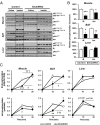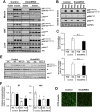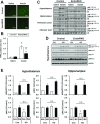Endothelial insulin receptors differentially control insulin signaling kinetics in peripheral tissues and brain of mice
- PMID: 28923931
- PMCID: PMC5635907
- DOI: 10.1073/pnas.1710625114
Endothelial insulin receptors differentially control insulin signaling kinetics in peripheral tissues and brain of mice
Abstract
Insulin receptors (IRs) on endothelial cells may have a role in the regulation of transport of circulating insulin to its target tissues; however, how this impacts on insulin action in vivo is unclear. Using mice with endothelial-specific inactivation of the IR gene (EndoIRKO), we find that in response to systemic insulin stimulation, loss of endothelial IRs caused delayed onset of insulin signaling in skeletal muscle, brown fat, hypothalamus, hippocampus, and prefrontal cortex but not in liver or olfactory bulb. At the level of the brain, the delay of insulin signaling was associated with decreased levels of hypothalamic proopiomelanocortin, leading to increased food intake and obesity accompanied with hyperinsulinemia and hyperleptinemia. The loss of endothelial IRs also resulted in a delay in the acute hypoglycemic effect of systemic insulin administration and impaired glucose tolerance. In high-fat diet-treated mice, knockout of the endothelial IRs accelerated development of systemic insulin resistance but not food intake and obesity. Thus, IRs on endothelial cells have an important role in transendothelial insulin delivery in vivo which differentially regulates the kinetics of insulin signaling and insulin action in peripheral target tissues and different brain regions. Loss of this function predisposes animals to systemic insulin resistance, overeating, and obesity.
Keywords: brain insulin action; endothelial cells; feeding behavior; insulin receptor; insulin resistance.
Conflict of interest statement
Conflict of interest statement: Masahiro Konishi is an employee of Daiichi Sankyo and was on sabbatical leave at Joslin Diabetes Center when the study was completed.
Figures














Similar articles
-
Skeletal muscle-specific deletion of lipoprotein lipase enhances insulin signaling in skeletal muscle but causes insulin resistance in liver and other tissues.Diabetes. 2009 Jan;58(1):116-24. doi: 10.2337/db07-1839. Epub 2008 Oct 24. Diabetes. 2009. PMID: 18952837 Free PMC article.
-
Paraoxonase1 (PON1) reduces insulin resistance in mice fed a high-fat diet, and promotes GLUT4 overexpression in myocytes, via the IRS-1/Akt pathway.Atherosclerosis. 2013 Jul;229(1):71-8. doi: 10.1016/j.atherosclerosis.2013.03.028. Epub 2013 Apr 10. Atherosclerosis. 2013. PMID: 23639858
-
Chlorella modulates insulin signaling pathway and prevents high-fat diet-induced insulin resistance in mice.Life Sci. 2014 Jan 24;95(1):45-52. doi: 10.1016/j.lfs.2013.11.020. Epub 2013 Dec 11. Life Sci. 2014. PMID: 24333277
-
Metabolism and insulin signaling in common metabolic disorders and inherited insulin resistance.Dan Med J. 2014 Jul;61(7):B4890. Dan Med J. 2014. PMID: 25123125 Review.
-
[Relative importance of insulin actin in insulin's target tissues].Nihon Rinsho. 2000 Feb;58(2):291-6. Nihon Rinsho. 2000. PMID: 10707547 Review. Japanese.
Cited by
-
Peripheral Insulin Regulates a Broad Network of Gene Expression in Hypothalamus, Hippocampus, and Nucleus Accumbens.Diabetes. 2021 Aug;70(8):1857-1873. doi: 10.2337/db20-1119. Epub 2021 May 24. Diabetes. 2021. PMID: 34031123 Free PMC article.
-
Pursuing the Molecular Nexus Connecting Diabetes and the Associated Cognitive Impairments.J Neurosci. 2019 Oct 30;39(44):8614-8616. doi: 10.1523/JNEUROSCI.1232-19.2019. J Neurosci. 2019. PMID: 31666334 Free PMC article. No abstract available.
-
Molecular Mechanisms of Hypothalamic Insulin Resistance.Int J Mol Sci. 2019 Mar 15;20(6):1317. doi: 10.3390/ijms20061317. Int J Mol Sci. 2019. PMID: 30875909 Free PMC article. Review.
-
Role of the Blood-Brain Barrier in Central Nervous System Insulin Resistance.Front Neurosci. 2019 Jun 4;13:521. doi: 10.3389/fnins.2019.00521. eCollection 2019. Front Neurosci. 2019. PMID: 31213970 Free PMC article. Review.
-
Fat, Obesity, and the Endothelium.Curr Opin Physiol. 2019 Dec;12:44-50. doi: 10.1016/j.cophys.2019.09.003. Epub 2019 Sep 19. Curr Opin Physiol. 2019. PMID: 31976384 Free PMC article.
References
Publication types
MeSH terms
Substances
Grants and funding
LinkOut - more resources
Full Text Sources
Other Literature Sources
Medical
Molecular Biology Databases

